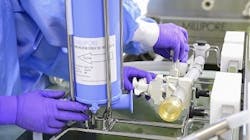The biological drug products market is expanding, especially in emerging economies. With the improvement of living standards in those countries, the number of patients accessing drug treatments is growing rapidly. In Brazil alone an estimated 40 million people joined the middle class between 2000 and 2010. In China rapid economic growth and the emergence of a middle class with growing disposable income in the last decade have contributed to an increased demand for high-quality healthcare services. In India the number of middle class households (earning between $4,413 and $22,065 a year) is estimated to increase more than four-fold, from $32 million in 2010 to $148 million by 2030.
Countries that are growing in size and wealth are looking to establish more domestic industries to support a growing population that can afford to buy more goods and services. In particular, government-driven incentive programs are multiplying to encourage local investments in biologics production facilities. For example, if a company in Brazil decides to build a modern manufacturing plant to produce a product for the local market, the government will buy this product from the company. Companies that do not have plants in Brazil will eventually be eliminated from the market for a particular product. In India the government has been proactive and supportive in driving the growth of the biotechnology sector by offering grants and tax incentives, and implementing investment-friendly regulations.
Since the mid-1980s, South Korea is by far the best example of government support for the biotechnology industry. One of the fastest-aging countries demographically in the Organization for Economic Co-operation and Development (OECD), South Korea needs to prepare for and deal with the rising incidence of chronic diseases such as diabetes, Alzheimer’s and Parkinson’s. The government provides various incentives such as tax reductions or cash grants to companies targeting treatment of those specific diseases.
In other cases, governments apply a protectionism strategy favoring a model where drugs must be produced locally to be eligible for local healthcare system reimbursement or to be available for patients. In Russia, for example, local pharmaceutical companies are able to meet only a small percentage of the country’s requirements and 80 percent of drugs are imported. To change this situation, Russia is implementing extreme protectionist policies such as a law that allows discriminatory procurement practices by giving the government the right to enforce a ban on foreign goods in public procurement tenders.
At the same time, some biologics blockbuster patents going to public domain lead to development of multiple biosimilar programs, benefiting the broader population with lower treatment costs. With more than 200 biosimilar drug development programs – spanning from research to Phase III – in China, Brazil, India, Turkey and Russia alone, biosimilars are becoming a public health challenge and a large business opportunity in many countries.
This overall situation is leading to a new “for country in country” strategic trend in biopharmaceutical industry supply chains where biopharmaceutical companies are considering localizing small scale production facilities to serve specific countries or regions.
The design of Flexware assemblies assures correct installation every time.
However, there is a high level of risk related to investments in emerging countries. Political instability can be of great concern in some countries, turning a winning market environment into a real no-go in a matter of months. Economical fragility and a government’s inability to fund existing incentive programs often limit attractiveness of those markets. Also, the limitation – or absence, in some cases – of healthcare systems, as well as relative complexity of drug reimbursement processes may limit populations’ access to drug treatments.
Companies interested in investing in biologics in emerging countries such as Brazil, Russia, India, China and in middle-eastern and Asian-Pacific countries must solve an equation which consists of investing quickly to be the first to enter, lowering the financial risks and ensuring drug products cost of goods sold (COGS)are competitive and affordable. The key to this equation is the flexible factory concept.
The flexible factory concept is a single-use facility designed with ease of use, minimized contamination risk and flexibility in mind. A wise implementation of single-use technologies allows drug manufacturers to get the best possible outcome from those technologies: easy and fast re-purposeability for a variety of processes, increased capacity with rapid changeovers between batches, minimization of SIP/CIP steps with associated time and costs savings. The ability to run some of the process steps closed and continuously also allows fewer cleanroom classifications and reduced capital expenditures while increasing facility flexibility and adaptability to meet local market demand.
Despite the introduction of single-use new technologies, the majority of biotech processes and facilities still contain a number of stainless steel and multi-use equipment. At EMD Millipore, a subsidiary of Merck, the company made the decision to move away from this traditional setup and implement full single-use processes at both the laboratory and manufacturing scale. This change from multi-use to single-use was developed in parallel with the revamping of EMD Millipore’s Biodevelopment Center in Martillac, France, as well as part of the company’s global strategic development of flexible facilities concepts.
ALL STEPS UP, AND DOWN STREAM
With the adoption of single-use equipment, all steps from upstream to downstream and fill and finish can be completed in a single-use manner. This is not only true for small and medium scale; large scale disposable systems are now available on the market and routine manufacturing can be done using disposables as well. EMD Millipore’s implementation of disposables is going from development scale to routine manufacturing at the 2,000 liter scale.
EMD Millipore has seen a number of advantages to implementing single-use equipment including reduced risk of contamination, ease of use and enhanced flexibility. The risk of contamination is reduced at all steps as the disposable systems arrive sterile with no need to clean or sanitize, and are set up for the run without opening. As an example, bioreactor bags are connected to media bags through sterile connectors so there is no open phase and the harvest is completed the same way. Welders can be used as well, depending on the scale.
Ease of use is threefold. First, operators require less training than with stainless-steel equipment (less piping, no spare parts, no cleaning or sanitization, etc.). Second, the assemblies used on the hardware part are typically preconfigured for simplified installation (connectors with “two clicks” confirm good connections, asymmetric pieces avoid bad orientation, etc., Figure 1). Finally, operations are mostly automatic and the recipes used are virtually foolproof.
In terms of enhanced flexibility, EMD Millipore has found implementing single-use equipment to yield a range of advantages. For one, bioreactors are no longer fixed; they can be moved from one room to another depending on needs. Downtime is reduced to a few hours rather than several days, as is the case with stainless steel. When running a single-use upstream suite, drug A can move from one bioreactor to three in parallel for the validation runs of drug B in less than a day. The ability to reconfigure in a day or less provides superior flexibility and allows quick changes in production plans.
Buffers are prepared in single-use mixers and then pushed into the suite for use. As nothing is fixed, there is no need for hard piping and maximum flexibility in the options. A new buffer can be brought in or taken out without impacting the suite and the rest of the process.
New generations of equipment, such as the Mobius’ FlexReady System, make it possible to have one piece of equipment for several operations. The tubing has been replaced by a new type of consumable that prevents operator errors (Figure 2). These systems enable either chromatography or TFF with a single piece of equipment. The additional cart will contain pumps for chromatography or a tank for TFF. This new concept not only reduces footprint, but also investment and operator training. Flexibility is embedded in the equipment design. All of this equipment can be connected using sterile connectors or welders, making running a closed process now feasible.
IN THE BAG
Instead of using a vial, cells can be stored in a bag at -80°C or in Nitrogen. This bag is connected by welding to the first seeding bioreactor and cells are transferred by gravity. Cells are grown to the desired concentration and transferred again by sterile connection to the next bioreactor and so on until the production unit. The next steps through clarification are similar and the resulting clarified harvest is collected into a closed bag.
Purification can also be performed in a closed and continuous manner using several columns consecutively loaded, washed, eluted, cleaned and regenerated. Virus inactivation happens in a closed bag between protein capture and a series of membrane absorbers. The process ends with virus filtration and aliquoting.
This closed process has several advantages, including reduced risk of contamination andthe ability to run a multiproduct facility with ballroom suites for upstream and downstream or several products in the same area. These benefits are creating a clear global trend toward single-use equipment and flexible facilities concepts.




